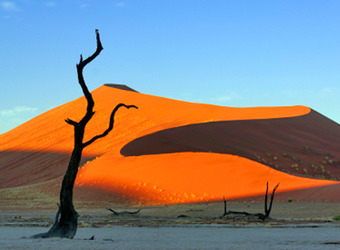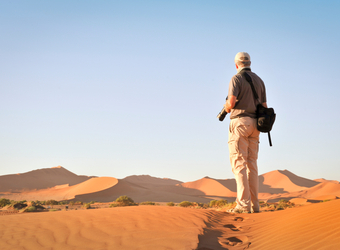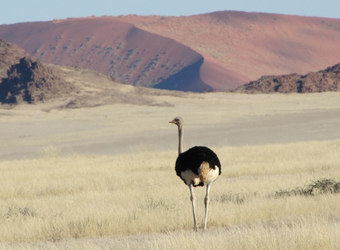Sossusvlei
Click here to be the first to review Sossusvlei
Start Planning Your Custom Safari view larger image
view larger image
A vast clay pan surrounded by the world's tallest sand dunes, Sossusvlei is one of the most striking vistas in all Africa. The dunes soar a thousand feet high in the lonely Namib Desert, shape-shifting mountains of golden sand framed by intense blue skies. Sunrise and sunset are magical, when the dunes appear burnt orange and deep carnelian red. Surprisingly, Sossusvlei is home to a variety of desert-adapted wildlife.
 view image gallery
view image gallery
The Safari Experience
The Namib Desert is the oldest in the world, with the highest sand dunes on Earth. Sossusvlei is the archetypal image of Namibia, where dry lakebeds or clay pans called vleis are surrounded by a perimeter of massive orange sand dunes. Early morning nature drives into this desert realm are complemented by optional hot-air ballooning, quad biking within the private 91,500-acre Kulala Wilderness Reserve with a private entrance to the park, and walks atop the crests of towering dunes such as “Big Daddy,” the largest. At the foot of this thousand-foot dune is Deadvlei, one of the most beautiful vleis filled with striking 900-year-old tree skeletons, scorched black from the sun and forever preserved by the dry desert. Near Sossusvlei, add a visit to Sesriem Canyon, excavated from local sedimentary rock by the Tsauchab River.
 view image gallery
view image gallery
Wildlife
Sossusvlei is not a primary wildlife destination, however a sparsely distributed array of desert-adapted animals ekes out an existence in this stark scene, including ostrich, springbok and gemsbok, Namibia’s national animal. On occasion, spotted hyena or, more rarely, brown hyena, may be sighted along with primarily nocturnal creatures like the bat-eared fox, Cape fox, black-backed jackal, porcupine and aardwolf. The coastal fog that rises from the sea at dawn can drift inland up to 30 miles, permitting the survival of various insects, rodents and reptiles in an otherwise parched environment. Geckos, small chameleons, and scorpions subsist almost undetected, but on walks you will see their trails cutting through the sand and are likely to see them with close scrutiny. The petite, sand-colored dune lark’s distribution is limited entirely to this area, making it a rare and special bird sighting.
 view image gallery
view image gallery
How to Include Sossusvlei in Your Safari Itinerary
Recommended Number of Nights
Nature Travelers: 2 nights
Photographers: 2 nights
Families: 2-3 nights to take in all the activities
Active Travelers: 2 nights including dune hikes and quad biking
Other Regions to Include
Sossusvlei is an iconic desert landscape experience, with sparse and intermittent wildlife. It is a key part of any classic, well-rounded Namibia trip, but can be combined with the other areas of Namibia to incorporate an assortment of animals and ecosystems. Damaraland, to the north of Sossusvlei, is a slightly different desert-scape, with dunes broken by rugged mountains and desert-adapted elephant and rhino. From here, Hartmann Valley is one of Africa’s most remote locations and stunning landscapes, set along the Kunene River, which creates Namibia’s northern border against Angola’s craggy mountains. Etosha National Park is Namibia’s the primary wildlife viewing area, with lion, leopard, elephant, rhino and a variety of plains game. A great place to conclude a Namibia safari is Okonjima, which runs a large feline predator research and rehabilitation program. Sossusvlei also links well with Botswana’s Okavango Delta, Linyanti and Kalahari Desert regions to provide a more extensive wildlife experience.
